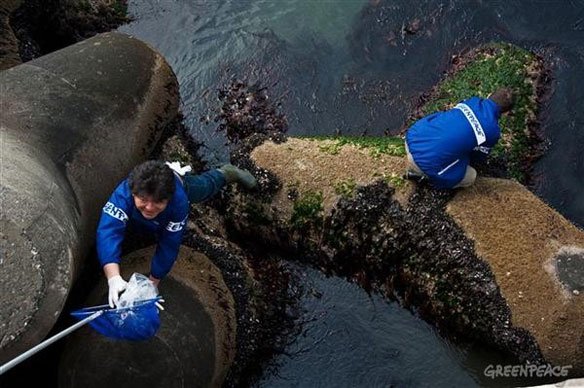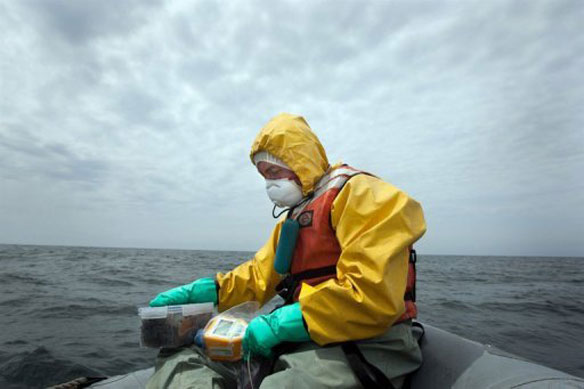Report From Japan: No News Is Good News?

Testing marine contamination along Fukushima coast. Caption and photo source: ©Greenpeace
Excerpts;
Controlling information flow in a crisis is crucial to its outcome. So it should come as no surprise that much information received about how the crisis at Fukushima unfolded has been kept away from traditional and social media as long as possible. In the end, however, the truth does (eventually) come out…
Read Full Article, in Huffington Post
Japanese Government must immediately investigate seaweed contamination: Greenpeace Reports
By Greg McNevin, Greenpeace International

Initial findings from our radiation sampling team working on the coast near Fukushima are in and the news is not good. The results showed levels of contamination far beyond allowed limits for seaweed. Contaminated seaweed could become a threat as fishermen along the coast will begin harvesting the seaweed to sell for public consumption in the coming weeks. Caption and photo source: ©Greenpeace
Greenpeace, May 12th, urged the Japanese authorities to undertake comprehensive radiation testing of seaweed along the Fukushima coast, after initial results from marine radiation monitoring carried out by the international environmental organisation showed levels of contamination far beyond allowed limits.
Initial tests of the 22 seaweed samples collected by Greenpeace along the coast North and South of the crippled Fukushima Daiichi nuclear plant, and up to 65km out to sea by its flag ship Rainbow Warrior registered significantly high levels of radioactive contamination. Ten samples show levels over 10,000 Bq/kg, while the official safety limits for seaweed are 2,000 Bq/kg for Iodine-131 and 500 Bq/kg for Caesium-137.
“From May 20, fishermen along the coast will begin harvesting seaweed for public consumption, our research indicates a significant risk that this seaweed will be highly contaminated,” said Ike Teuling, Greenpeace radiation expert. “As both TEPCO’s sediment samples and our own preliminary research shows, radioactive contamination is accumulating in the marine ecosystem that provides Japan with a quarter of its seafood, yet the authorities are still doing the very little to protect public health.”
“For the coastal communities trying to rebuild lives and get back to work after the March 11 earthquake and tsunami, radioactive contamination of the marine food web is exacerbating an ongoing tragedy,” said Wakao Hanaoka, Greenpeace Japan Oceans Campaigner.
“It is crucial that the government immediately undertakes a study of seaweed contamination off Fukushima to protect the health and safety of fishermen and consumers, and so full compensation is given to communities affected by this ongoing nuclear disaster.”
Greenpeace is now conducting detailed analysis of fish, seawater, and seaweed collected outside of Japan’s 12 mile territorial waters, as well as fish, shellfish and seaweed samples collected from the Fukushima coast. A selection of samples have been sent to independent laboratories for further analysis, full results are expected to be released next week.









